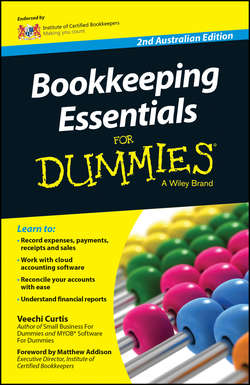Читать книгу Bookkeeping Essentials For Dummies – Australia - Veechi Curtis - Страница 3
На сайте Литреса книга снята с продажи.
Introduction
ОглавлениеBookkeeping has changed enormously since I first started as a bookkeeper in my late teens, writing up accounts by hand in leather-bound journals in my hometown of Edinburgh, Scotland. Accounting software has replaced handwritten books, emails have largely replaced the postal service, and the ability to add up in one’s head is now an anachronistic party trick. However, one thing has stayed the same. A bookkeeper remains a person upon whom most businesses depend.
Bookkeeping Essentials For Dummies aims to be a reference for any bookkeeper. Are you wondering about the difference between an asset and a liability, how GST works or how to calculate an employee’s take-home pay? Then I hope this book can be your go-to guide. I also talk about the major changes that have occurred in the bookkeeping industry in recent years, such as cloud accounting, browser-based software and bank feeds, and how these changes affect the way you do your day-to-day work.
About This Book
In this book, I talk about bookkeeping for all sizes of business. I cover essential topics such as how to record expenses or raise customer sales, how to balance a bank account, processing an employee’s pay, and applying GST correctly. I also explain the basics of employee payroll, and how to generate financial reports.
Because of the smaller size of this book, I don’t delve into some of the more complex bookkeeping topics, such as calculating depreciation, working with inventory or making general journals, topics which fall into a grey area between the responsibilities of a bookkeeper and those of an accountant. If you want to know more about these topics, you may want to get a hold of my ‘big’ bookkeeping book, Bookkeeping For Dummies, Second Australian & New Zealand Edition.
Foolish Assumptions
Because I’m so blindingly sensible, I don’t make any foolish assumptions about you, dear reader. I don’t assume that you have any bookkeeping experience or even that you’ve worked in a business before (although it’s possible, of course, that you’re a bookkeeper extraordinaire with 30 years’ experience under your belt). All I assume is that you are at least vaguely interested in bookkeeping and the results that the process yields.
Icons Used in This Book
Throughout this book you find icons in the margins to help you navigate through the text. Here’s what these icons mean:
Want to be streets ahead of the competition? Then look for this handy icon.
You find this icon next to stuff relating to GST or taxation (ah, such fascinating topics).
This icon flags information to do with working online, in the ‘cloud’.
Tie a knot in your hankie, pin an egg-timer to your shirt but, whatever you do, don’t forget these little nuggets.
This icon points the way to doing your job better, faster and smarter.
A pitfall for the unwary. Read these warnings carefully (then you can’t say no-one told you ...).
Where to Go from Here
Bookkeeping Essentials For Dummies isn’t a gripping novel to be read from cover to cover. This book is designed (all 12 bite-sized chunks) so you can pick it up at any point and just start reading.
If you’re new to business and trying to set up a bookkeeping system from scratch, I recommend you read Chapters 1 to 3 before doing much else. If you’re trying to figure out how best to organise paperwork and record sales and expenses, then Chapters 4 to 6 are made for you. Chapters 7 to 9 provide a reference for more technical stuff, such as understanding GST, working with payroll and reconciling bank accounts. And finally, Chapters 10 and 11 deal with the topics of financial reports and starting a new financial year, while Chapter 12 provides some guidance about starting your own bookkeeping business.
Five Tips for Collecting Money
•Draw up a credit policy. If you’re charged with chasing money from customers, you want to have a set of rules that outlines the deal for any customer who receives credit. This is called a credit policy and, if such a policy doesn’t yet exist, you may need to prompt the business owners to create this document.
•Do your homework. Just asking a customer to complete a credit application isn’t enough. Take the time once you receive the application to perform a thorough background check.
•Don’t waste a moment. When a customer’s account runs overdue, get on the phone straightaway. Start chasing as soon as an account is seven days overdue. The longer you leave a debt before chasing it, the more risk you run of not getting paid.
•Calculate the cost of debts. Not only does the business risk increased bad debts the longer they wait before chasing money, but slow-paying customers also tie up valuable capital.
•Keep a dossier. Keep track of every phone call made, every reminder sent and every promise received. Sometimes it takes months, numerous phone calls and many emails or letters before you succeed in getting someone to pay, and if you repeat this process with a lot of debtors, you soon lose track of who promised what.
Visit dummies.com for free access to great For Dummies content online.
